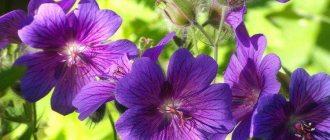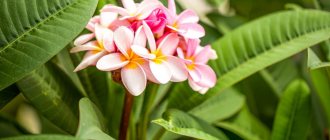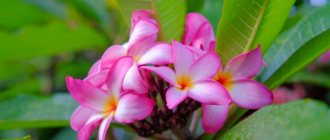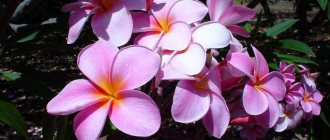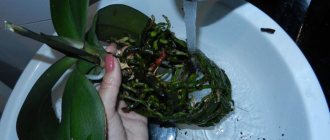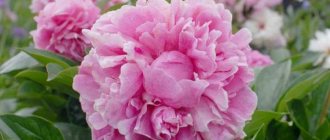Plumeria or frangipani - this plant can rightfully be considered divine. Plumeria flowers have a persistent, exquisite aroma and do not lose their beauty when picked for a month. Tropical islands with a mild and humid climate are considered the homeland of this unusual flower. For the first time, travelers saw this flower in the Caribbean islands. It bloomed on a huge tree, at least ten meters high. And its aroma was incomparable to more than one flowering plant. A feature of plumeria is the ability to change its aroma depending on growing conditions. It is quite difficult to describe the smell of this plant. Each person finds in it the aroma that he wants to hear. For many, the aroma of plumeria resembles the smell of lily of the valley, hydrangea, jasmine, citrus fruits, magnolia or the subtle aroma of spices.
This plant belongs to the Kutrov family. The homeland of plumeria is considered to be South America, Thailand, Bali, Mexico and other tropical islands. In their natural habitat, there are several species of plumeria.
And it grows in the form of a mighty tree with a fleshy crown and large green leaves. Flowers appear in the middle of the plant, and not on the side shoots. And they are dense five-leaf inflorescences that do not have stamens. Their appearance has given rise to many legends and speculations about the origin of this plant. Its peculiarity is considered to be the ability of flowers, when picked, to retain their pristine beauty. The aroma after cutting the flower is also not lost and makes it possible to feel it on the skin for a long time. Flowers are a symbol of Thailand; they are used to make wreaths and decorations for tourists. They are considered the best decoration for weddings and special ceremonies. Their appearance is very important in national culture. The color of plumeria petals, depending on the plant variety, can vary from soft white to bright scarlet, it can be pink or yellow; currently there are varieties of plumeria with two colors in the color of the flower petals.
How does plumeria grow in its homeland?
Plumeria grows in hot, tropical climates. Loves moist air and constantly moist soil. It does not tolerate drying out of the soil and at temperatures below 15 degrees, the plant dies. The maximum temperature in summer is 20-25 degrees, and in the winter rest period it is not lower than 17 degrees. The root system of this plant is quite well developed, there are above-ground roots and a developed underground part. The trunk is dense and strong, withstanding tropical winds and downpours. Very often this plant was planted in cemeteries and churchyards.
A plumeria tree that blooms for a long time should remind people of eternal peace and respect for the departed. It is also called the “tree of eternity”, since even if a young shoot of plumeria is pulled out of the ground, it will continue to bloom.
Requirements for planting container and soil
The tropical tree has powerful roots, so to grow it, immediately take a spacious and deep pot. Some inept gardeners often trim large root shoots. This is very dangerous and can lead to the death of the entire plant. As well as the wrong selection of substrate. Purchased soil or prepared soil yourself from leaf turf and peat (taken in equal proportions) is suitable. Peat, humus, sand and turf are also sometimes mixed in equal parts. The main thing is to periodically loosen the substrate to provide the roots with a stable supply of oxygen.
How to grow plumeria in your own garden
Many gardeners could not help but become interested in this amazing plant. And the desire to grow it on your own plot is very great. The seeds of this plant, as well as its cuttings, can be purchased at the store or brought from tropical countries yourself. In Europe, plumeria seeds are sold immediately in bags with soil, for ease of growing. The only “but” that stops many gardeners is doubt about the flowering of this beautiful plant. The plant cannot tolerate cold weather and freezing of the soil, the root system instantly weakens and the plant dies. But the solution to this problem is quite simple - you can grow plumeria in a flowerpot and take it from the street in the autumn and winter. Or plumeria grows well in greenhouses and winter gardens, subject to certain conditions.
Diseases and pests
Root system rotting. The reason is stagnation of water in the root system due to excessive watering. The problem can be solved by replanting the plant and removing damaged parts of the root. Root sections must be sprinkled with wood ash.
Among the pests, the main enemies of plumeria are considered to be mealybugs and spider mites; they can be eliminated using special products, which are widely available in gardening stores.
Spider mite
Mealybug
Growing plumeria from cuttings
- To grow plumeria from a cutting into a young plant, it is necessary to observe certain conditions and know the characteristics of the development and growth of this plant. If you bought a cutting in a store, be sure to inspect it for leaf diseases. If possible, inspect the root system. At home, the plant must be replanted in a fresh earthen mixture; for this you can use light soils for flowering plants or mix one part of humus, two parts of earth and rotted leaves or pine bark yourself.
- The soil for the plant should be slightly acidic. Expanded clay or broken bricks should be placed at the bottom of the container; this will help prevent rotting of the roots with constant watering. It is better to choose a plastic container for planting, since clay containers can injure the roots of a young plant, do not allow sufficient heat to pass through, and they are quite heavy. And plumeria needs to be replanted every year. The earth mixture should be well moistened, after which a young cutting is placed in it.
- If the plant has more than three leaves, this indicates that the plant is in good condition. The young plant is a thick stem with a rosette of leaves at the top. If there are side shoots, this indicates that the plant is not very young and may have undergone flowering. On the stem of a plant you can sometimes see “stretch marks”, a young formation of bark; this is not damage, but is typical for some types of plants. It is better to plant during the plant's dormant period, which occurs from October to March.
Propagation by cuttings
It is convenient to propagate plumeria using young shoots - cuttings. They quickly take root and begin to bloom within a year after rooting. You can cut “babies” from the mother tree at any season, but it is advisable to do this in winter or autumn. To do this, the semi-lignified tops of long shoots are cut at an angle of 45 degrees. Remove all leaves from them and sprinkle the cut areas with crushed activated carbon. The shoots are wrapped in a clean, damp cloth and stored in a warm place for several weeks.
Then they are soaked in a rooting solution and placed in separate small flowerpots with universal loose soil. Place drainage at the bottom, such as large pebbles. Then lay out the soil and a layer of moistened river sand. It is necessary so that the cuttings do not rot. The top of the shoot is again sprinkled with prepared soil and lightly compacted. At the end, light watering is carried out. Flowerpots with young shoots are placed in a warm room. After 2-3 months, with successful rooting, young buds appear on the cuttings.
Plumeria care
After planting, the plant needs regular watering and frequent spraying. Plumeria loves warm, settled water for irrigation. Does not tolerate drying out of the earthen coma. The plant is sprayed daily with clean warm water. In the active growth phase of the plant, spray in the morning and evening. In the slow growth phase, once a day is enough - in the morning. The root system of plumeria develops quite quickly, and the growth of the plant itself depends on its development. Plumeria is a tropical plant and with proper care it should be replanted every year. It is better to do this in April. After five years, the plant can be replanted every three years. When replanting a plant, you need to trim the lateral and main roots by five centimeters. This allows the root system to develop and the plant to bloom better. In mature plants that are not replanted, the top layer of soil must be changed twice a year. Throwing out the old soil and replacing it with new. You also need to mulch the top layer of soil of the plant, protecting it from drying out and washing away. You can mulch with coconut fiber or perlite. The plant needs to comply with the light regime. There should be at least six hours of daylight. In this case, plumeria can be in the open sun. If there is not enough light, the leaves begin to turn yellow and appear more lethargic. During the entire period of life, the plant should receive the maximum amount of light. If you take the plant into the house for the winter, then make sure that it stands in the southern room near the window or on the windowsill. The plant does not like drafts and freezing of the soil. If the floor is cold, you can place planks or soft cloth under the container.
During the growth period, the plant must be fed. Fertilizers can be purchased from the store for flowering plants. In the first months of spring, fertilizing with nitrogen fertilizers is necessary. During the summer months, in extreme heat, fertilizing is not recommended.
Flowers - Your favorite magazine
Among flower growers and botanists, this plant is known as plumeria, and florists usually call it frangipani. It is this exotic beauty that we will talk about today.
Its scientific name is Plumeria -
The plant was named in honor of the French botanist Charles Plumier (1646-1704), the first scientist to describe it during an expedition to Central America. Plumier also compiled the first scientific description of magnolia and begonia, and introduced the generic names Lobelia and Besleria into botany. The plant received its second name in honor of the noble dynasty of perfumers from Italy, Frangipani, which produced perfumes based on plumeria flowers in the 16th century. By the way, their great admirer at one time was Catherine de Medici (1519-1589), the wife of King Henry II of France from the Valois dynasty, thanks to whom this perfume became fashionable and very popular in the high society of Europe.
Red, white and co
The most common types of plumeria in culture are white ( P. alba
) and red (
P. rubra
). The first species is native to the Greater and Lesser Antilles. White plumeria trees can reach a height of 10 m. Their leaves are elongated-oval, up to 30 cm in length and up to 7 cm in width. The flowers are white, with a yellow center, up to 2.5 cm in diameter, and have a very strong, pleasant aroma.
The second species is found naturally in Mexico and Venezuela. It is a tree up to 5 m tall with red fragrant flowers up to 5 cm in diameter. Leaves are up to 50 cm long and up to 15 cm wide, obovate in shape. In both species, leaves completely or partially fall off during the dry season.
Other types of plumeria ( P. bracteata
,
P. clusioides ,
P. filifolia
, P. inodora ,
P. obtusa
,
P. pudica
,
P. stenopetala cultivation ;
most often, not species, but varietal
plumeria are grown , in including those obtained as a result of interspecific hybridization ( ' Aloha '
,
' Aphrodite '
,
' Bali Whirl '
,
' Firecracker '
,
' Coral Cream '
,
' Curly White '
,
' Dwarf Gem ', ' Jacks Purple '
,
' King Kalakaua '
,
' Muang Puang '
,
' Orange Bouquet '
,
' Pink Sunset '
,
' Rainbow Star '
,
' Red Velvet '
,
' Vishnu Gold '
and others). They differ in the size of the tree or bush, the size and shape of the leaves, the size, shape (simple, semi-double, double) and color of the flowers (white, various shades of yellow, apricot, peach, orange, pink, red, crimson, lilac, sometimes with contrasting center, stripes, border, smooth color transitions).
Temple tree
The main advantage of frangipani is its bright, catchy tropical beauty. Therefore, the plant can be found not only in its homeland, but also in many other places: in Thailand, Singapore, Laos, Bali, Indonesia, Australia, India, Java, the Philippines, Madeira, and the Canary Islands. Even one flowering frangipani tree or bush (and it blooms long and profusely) transforms the surrounding space, introducing distinct notes of holiday and celebration into it, accompanied by a wonderful aroma with tones of citrus, jasmine, and gardenias. It is not for nothing that plumeria was chosen as the national flower in Bali and Laos.
In Buddhist countries, frangipani symbolizes immortality, which is why it is often planted near temples and is called the “temple tree.” In India, plumeria is called the “tree of life”, since its branches, even cut, continue to open their buds and bloom for some time due to the reserves of water and nutrients they contain. However, contrary to the above, in some places in Southeast Asia this plant symbolizes death.
Hare Krishnas claim that frangipani was the most favorite flower of their main god. Among the Mayan Indians, plumeria served as a symbol of eroticism and lust. The Aztecs used its flowers to decorate altars, and only daughters of leaders had the right to insert frangipani flowers into their hair. In what is now Peru, the sacred plumeria flowers that fell from the trees were used in religious ceremonies, and therefore ordinary Indians were forbidden to touch them on pain of death. Currently, in some places in tropical America, plumeria is dedicated to the Blessed Virgin Mary.
Where plumerias grow, their flowers often accompany the natives during important life events, both joyful and sad (birth and death, love and marriage, various religious, social and political events). In the Hawaiian Islands, frangipani flowers and other plants are used to make fragrant flower garlands called leis, which locals and tourists hang around their necks.
Recipe for success
Residents of the tropics are lucky: here you only need to “stick” a plumeria seedling into the ground and wait until it starts to bloom. But in order to grow, and especially get flowering specimens of frangipani at home, in a winter garden or greenhouse, you will have to try.
The three pillars on which success in growing plumeria is based are good lighting, regular watering and fertilizing. For frangipani, choose the brightest place in the room, which in the summer is well illuminated by the sun for at least six hours a day. For plumeria, both insufficient and excessive watering are equally harmful; this can lead to sudden loss of leaves, rotting and even death of the plant. The soil in a pot with plumeria should always be moist, so in hot weather it is watered with warm, settled water every day, and rarely in winter, when the plants are at rest. At the same time, throughout the year it is useful to regularly spray plumeria with clean water, trying not to get it on the flowers.
During the growing season, it is recommended to feed plumeria once every two weeks. In this case, fertilizers are used with a predominance of phosphorus rather than nitrogen and the obligatory presence of microelements. The optimal composition of the substrate for frangipani is turf, peat, humus soil and sand in a ratio of 2:1:1:1. The substrate reaction must be neutral or slightly acidic. Since plumeria grows quite quickly and forms a powerful root system, take a large pot for it, at the bottom of which (about 1/5 of the height of the container) drainage must be arranged. It is recommended to replant young plumerias in early spring every two years. For old specimens, the top layer of soil is replaced annually, trying to injure the roots as little as possible.
In winter, plumerias, as a rule, go into retirement, shedding their old (and sometimes all) leaves. During this period, the soil is kept in a semi-dry state and care is taken to ensure that there are no drafts in the room and that the temperature of the air surrounding the plant does not fall below 15 °C. In summer, the optimal temperature for plumeria is 25-30 °C.
Pruning frangipani is usually not required; only dry, weak branches that violate the symmetry of the crown are removed. Sometimes plants can be attacked by spider mites, which should be combated by spraying plumerias with special preparations - acaricides.
From seeds and cuttings
Frangipani is propagated by sowing seeds and rooting cuttings, which tolerate transportation very well when wrapped in damp cloth and placed in a bag. To avoid problems at customs, it is useful to first clarify whether they can be exported from the country. However, now without any problems, seeds and cuttings of plumeria can be ordered on the Internet.
Before sowing, it is recommended to soak the seeds for 2-3 hours in warm water, then treat them with a fungicide and place them in the soil with the lionfish facing up, leaving the latter partially sticking out above the substrate. Fresh seeds germinate quickly and quickly, after 7-10 days. However, it must be taken into account that the seedlings do not fully retain the properties of the mother plant, they turn out to be of different colors and some of them will not be particularly decorative.
But plumerias grown from cuttings will turn out exactly the same as the plants from which they were cut. The optimal length of cuttings for propagation is 20 cm. Before planting in a loose substrate, they are treated with a root formation stimulator (for example, “Kornevin”), and then kept in a warm, well-lit place. Before rooting (this usually takes 2-3 months), it is advisable to cover them with an inverted glass jar.
Plants obtained from cuttings can delight you with their flowers already in the first year of life, and frangipani grown from seeds bloom at the age of 2-5 years. With good maintenance, plumeria begins flowering in late spring and ends in early autumn.
Healing aroma
Thanks to Catherine de Medici, in the 16th century perfumes based on plumeria flowers were very popular, produced by the Italian Frangipani dynasty of perfumers, in whose honor the plant received its second name. Modern perfumers also use essential oils of plumeria flowers when composing aromatic compositions. The absolute (that is, alcoholic extract) of frangipani flowers is already perceived as a ready-made perfume. The aroma of plumeria essential oil and absolute is characterized by perfumers as intense, rich, sweet, floral with hints of green, soft fruity or spicy notes in the background. At the same time, the shades of aroma vary depending on the type and variety of plumeria, location and growing conditions.
The aroma of frangipani has aphrodisiac properties, helps restore psychological balance and harmony, inspires, and therefore is used in aromatherapy to treat apathy, fear, stress, depression, and mental fatigue. In cosmetology (primarily in the composition of night creams and products for deep cleansing of the skin), an extract from plumeria oil is used, since it has anti-inflammatory, antioxidant and regenerating properties. The roots, bark, leaves and flowers of frangipani are used by Aboriginal people to treat a variety of diseases.
Relax flower
Many people associate frangipani flowers with the exoticism of tropical islands and relaxation; they are used to decorate tables, residential interiors, hotels, spas, and are often used by local florists to create a variety of compositions. The word frangipani
is mentioned in the names of a number of hotels in Bali, Malaysia and Sri Lanka.
Note to florists
Australian florist Marco Appelfeller shares his secrets of working with frangipani flowers:
“Working with frangipani is not easy. As soon as the flowers are cut from the tree, the tips of the petals are stuck together by the sap produced and quickly shrivel. The season when they can be used in Australia is from November to mid-February.
I really love frangipani and use it on special occasions when I create complex, intricate works, in design projects, for example, for floral collections. Fragipani flowers can be of various shades, so they can easily be integrated into almost any composition. At a temperature of 22-25 ◦C, flowers can remain without water for about two days. It is best to store flowers after cutting not in water, but in a closed plastic bag in a cool place; this way they will live longer. In arrangements and bouquets, I usually attach frangipani with wire or glue, because their stems are very short. Frangipani flowers are used to create wedding bouquets, corsages, boutonnieres and various medium-sized festive decorations. One bridal bouquet can consist of 200 individual frangipani flowers, held together with wire: you need to create something like a voluminous bunch to make them look natural. After handling frangipani, you should wash your hands well, as the sticky juice secreted by the flowers is very poisonous. For me, frangipani flowers symbolize friendship, the Pacific Islands and happiness. This is a flower that every florist should have the opportunity to work with to prolong its life and preserve its beauty for a long time.”
Alexey Antsiferov
Plumeria varieties for growing in our climate
In our climate, three varieties of plumeria give the best growing results.
- Red plumeria is the most common plant variety. It has a rather fragile trunk, and requires pruning of flowers after they fade. At the same time, it grows well, grows beautiful, large leaves and quite large bright scarlet flowers.
- Plumeria obtuse is the smallest plant and has the appearance of a subshrub. The leaves are dark green, veiny, sometimes curled. The color of the flowers is predominantly yellow or white with a yellowish tint. An easy plant to grow, most resistant to temperature changes.
- Plumeria alba is a classic type of plant. It looks like a tree with large leaves. It blooms with large, white flowers, which may have a yellow eye in the middle of the flower.
Feeding
Frangipani responds very readily to the application of mineral fertilizers to the soil. But in order not to overdo it, I always dilute it by half the dosage indicated on the package so as not to burn the roots.
I hope that this article has opened many eyes to this wonderful plant and encouraged you to have this fragrant flower at home.
Secrets of plumeria flowering
The main requirement of gardeners is the flowering of plumeria. But this process is long and not always successful. If the plant is grown from cuttings, then flowering occurs after 9-12 months of cultivation. If the plant is grown from seeds, then you will have to wait much longer for flowering, about three years. For successful flowering of plumeria, it is necessary to ensure its comfortable air temperature, proper watering and spraying, fertilizing with fertilizers and crown formation. As a rule, all lateral shoots and shoots that grow on the trunk must be removed. It is worth noting that plumeria has poisonous juice. And all work on crown formation should be carried out with gloves. Plumeria blooms on young shoots of the current year; if they are removed, flowering does not occur. If everything is done correctly, the plant will delight you with abundant color and aroma for a month or more. Flowers with a unique aroma and color will give the plant a solemn and festive look.
Rest period
During the winter months, plumeria begins a dormant period. Some varieties “rest” for up to 6 weeks. At this time, it is not advisable to apply fertilizing and fertilizers to the soil, or to carry out frequent watering and pruning. You should also monitor the air temperature. It should not fall below +14 degrees.
Old foliage partially dries out and falls off - this is a normal phenomenon in winter, and not a sign of disease. In spring, young shoots and buds will begin to appear in its place. Some specimens of ornamental shrubs do not hibernate at all. All winter they continue to actively grow and bloom. They need additional artificial lighting.
We grow plumeria in a flowerpot or tub
Growing plumeria in flowerpots allows the plant to be in the fresh air in the countryside or in the garden during warm periods. The pot with the plant should be placed in a well-lit place, making sure to place a board or other flat surface under it. This will provide the plant with protection from ants and other insects. Spraying and watering are done daily, even several times a day. With proper care, you can grow a tree or shrub up to two meters high. It is necessary to inspect the leaves of the plant daily, especially from the inside. And to avoid the plant becoming infected with spider mites, it is better to treat it with an insecticide. During the budding and flowering phase, you cannot spray the buds, only the leaves. At the end of flowering, the plant needs pruning.
Interesting fact about plumeria . This plant has another name - frangipani. It received this name thanks to the famous Italian perfumer and nobleman, who was the first to reveal the amazing properties of the essential oil of this plant. And based on it he created the first plumeria scent. The aroma later gained worldwide fame. And now it is considered one of the most powerful aphrodisiacs. This smell brings satisfaction and tranquility to a person, introducing a note of peace and pleasure.
Join our Facebook group
Frangipani from seeds
The easiest way to get this plant is to buy and plant a seed.
Which is what I did. Seeds today are not difficult to find; they are sold on specialized websites and in social networking groups. The main thing is to find a website that is convenient for you and place an order. The seeds are frost-resistant, so they can be ordered all year round. The cheapest Frangipani seeds I've come across cost 25 rubles. Video on the topic:
Germination is a lengthy process, it took me about a week, and you have to be very careful not to destroy the seedlings. First you need to prepare a very light soil that will dry quickly and not sour. I used universal soil with a large amount, about 50%, of disintegrants (perlite, silica, zeolite, vermiculite are suitable). Next, I placed the soil in the greenhouse, moistened it thoroughly and stuck the seeds into it with the wings facing up. The greenhouse must be kept warm (in winter you can use a radiator or a shoe dryer), ventilating it a couple of times a day so that the seeds do not get trapped.
